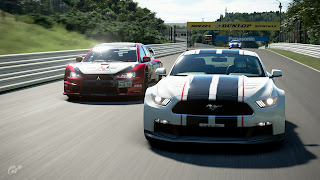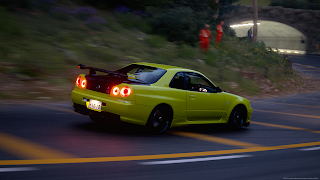Life's hard when you're a GC Impreza. After all, when asked to picture a first generation performance Impreza, every enthusiast will no doubt conjure up dreamy images of the unicorn of all Imprezas, the 22B, limited to just 400 built and sold exclusively in Japan. Really then, the only things that the... uh... let me make sure I get this exactly right here—the Impreza Coupe WRX Type R STi Version VI '99—has over the 22B is a much more complicated name, comes in colours other than blue, was sold and actually survived in export markets, and its potential to have two more doors and a lot more storage space.
In yet another dazzling display of PDLogic™, the second GC Impreza in this game is also a coupé, slinking it further into the shadow of its 22B brother. Really, sometimes I'm made to think that, instead of listening to what the fans want, or what would make the most sense to have in a game, PD includes cars solely out of convenience. "Oh, what is this, a factory fresh, well preserved Imp VI is being offered to us by Subaru themselves? Screw the Hawkeye, GET THIS IN!!!" I mean, if you've any other theories as to why we have 2 coupé GC8s in this game, no sedans, no wagons, no base Imprezas, no base WRXes, no GDs, no GEs, or any of the very many special editions of the cars, I'd love to hear it.
So, what does this week's Car of the Week have to offer that the 22B can't? Why, even more understeer, of course!
With soggy 1.7Hz springs propped up on miserable Comfort Soft tyres by default, there is nothing at all that screams "sporty" when the Imp VI is driven hard on a racetrack; only screams of the tyres and the frustrated driver going, "TURN GODDAMNIT WHY WON'T YOU?!" The patented Symmetrical All Wheel Drive system of Subaru's may boast a low cg, but that symmetry unfortunately means that the entirety of its flat four engine is overhung outside its wheelbase, resulting in a car that is as lopsided on the scales as a RR 911, with an eye popping, brain melting 62/38 F/R weight distribution. It should come as no surprise then, that an Imp VI asks of its driver to tiptoe cautiously into a corner as much as an air–cooled 911, only instead of death by oversteer, it punishes ham–fisted maneuvers with understeer in equal measure. Trail brake into a corner, and the car will lean immensely with the tiniest of steering angles, instantly overwhelming the outside tyres into smoking and screaming away any momentum and dignity you might have attempted to bring into said corner.
The longitudinally mounted 1,994cc EJ20 Boxer may rev to the cosmos at a Rotary–shaming 8,200rpm, but unfortunately, there isn't much of a reason to bring it past 7, with peak power of exactly 276HP (205kW) happening at 6,5. As with any tiny, rev happy engine, it really doesn't have any torque with which to hold a slide despite its stiletto–thin 205mm tyres, even with the most rearward torque split the OE centre differential can manage: a rather safe still 35:65. The gear ratios are similarly unintuitive, with the first four gears so short that you can't even hit Japan's Jishu–Kisei speed limiter set at 180km/h (112mph) in fourth, requiring the moonshot overdrive 5th for that, causing the car to completely fall over itself and die past said speed.
After just two races with the Imp, I had completely given up on it and began looking for alternatives. A 1999 Evo VI of some sort would be the most obvious candidate, but that's locked behind GT7, and so the next closest thing I had in GTS was a '96 Evo IV. The Evo IV, despite being 90 kilos (198lbs) heavier and packing 3 less horses, felt so much more nimble and lairy than the Imp with its breakthrough AYC system, though I couldn't translate any of it into tangible results at Tsukuba. In my frustration, I let something slip from my lips that I probably shouldn't have on race day: "Can I just destroy you all in my RX-7?"
"Can you?", was Vic's coy answer, and so I set about crippling the output of my 2002 Spirit R down to its advertised power of 276HP while leaving everything else as–is, including its mass. As I lined up among the field of Imprezas, I have to admit I felt more than a tinge of nervousness and doubt. The "grass is always greener on the other side syndrome", if there hasn't already been a clinical term coined for it. After all, at an unbelievably scant 1,260kg (2,778lbs), not only is the four seater AWD car somehow 10kg (22lbs) lighter than my mere 2 seater RWD car, but the sedan turned coupé also has a smaller and more nimble body than my bona fide sports car!
I uh... wound up utterly destroying the Imprezas in spite of all the deficits on paper. The FD is a car that I had complained was much too soft for my liking, but even that felt like a Gr.4 racing car after having jumped from the rally bred machines. It braked better, it cornered better, and past 180km/h, it went better than the Imprezas. The only advantage the Imps might have had was on corner exits, and even then, not by much from what I can tell glancing in my mirrors. I didn't win the race because nerves got the better of me, but I think I proved my point: the Impreza simply isn't set up for track use. I was even going to bring an R34 GT-R for an All Nippon AWD shootout, but that I think would be well overkill for the poor Subaru.
I had a really torrid time with the Impreza this week, and I would have written it off entirely had we not ran it on Bathurst, my favourite track in the world. There, the Impreza clung onto the racing lines like shrink wrap, displayed rock solid stability, and trivialised any of the many imperfections the public mountain roads presented. On a nefariously narrow and torturously twisty roads, the Impreza showed great "point and shoot" capabilities, biting into apexes with great initial turn–in before its understeer could rear its head, and its short gearing means it has torque and engine braking for any situation the varied mountain throws at it. And it's there that I really found where the Impreza felt most at home.
"Drift King" Tsuchiya Keiichi said it best in his modern impression of a GC8 Impreza: Subaru designs from the time all feel cheap, like they're made by country bumpkins. But, following that, he also comments on how it's such a nostalgic feeling for him to step into the car, and how it has a distinct "Subaru flavour" to it. That is something that I feel is not only distinctly absent in modern cars as Japanese manufacturers set their sights more and more on the global market, but also indicative of where and how an Imp VI shines: not on a wide, neatly paved track, but on a narrow, countryside road, where its unshakable AWD stability, compliant and absorbent suspension, and tiny Class 5 body is exactly what one would need to conquer country roads no matter rain, shine, snow, or anything in between. The fact that it can seat four in a body that's lighter and smaller than an FD RX-7's is something that still boggles my mind every time I see it. Even in the context of a video game, I can very clearly see why so many in real life have sworn by the Imprezas, and how it has arguably given Subaru its identity of rock solid, stable, and dependable workhorses worldwide. It somehow feels really personal simply to look at, akin to seeing pictures of a childhood friend from decades past.
To drive though? Oof, these early examples of AWD performance cars are rough! They serve as a stark reminder of a time when car manufacturers struggled to get an AWD car to simply turn like a car. Nowadays, we have AWD SUVs that can corner on par with supercars. The Imp VI then, is not only a veritable time capsule, but I think is also the closest thing we will ever get in a modern Gran Turismo game to the driving experience of an offroad SUV. It's an intriguing to experience because of that, but ooh boy is it not for me. I'd rather shorten my lifespan with a proper RWD sports car, or just buy an R34 if I have to. Hell, there's no reason at all for me to not just take a 22B over the VI.
(muffled screaming in the distance: "WHAT DO YOU MEEEEAN THE 22B COSTS 180K in GT7?!")





























